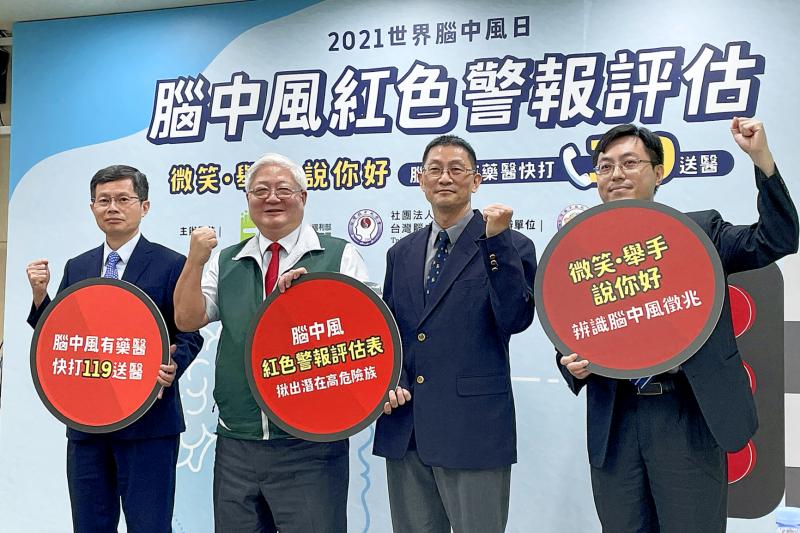The Health Promotion Administration (HPA) and the Taiwan Stroke Society (TSS) yesterday released a stroke risk assessment chart, consisting of eight main risk factors, to help people evaluate if they have a high risk of having a stroke, while also introducing a new slogan for people to use to quickly spot signs of a stroke.
HPA Deputy Director-General Wu Chao-chun (吳昭軍) said as World Stroke Day is Oct. 29, the HPA has teamed up with the TSS to introduce a stroke risk assessment chart.
Referencing the stroke risk scorecard released by the US National Stroke Association, the risk assessment chart lists eight risk factors, he said.

Photo: Chiu Chih-jou, Taipei Times
TSS president Lee Jiunn-tay (李俊泰), a professor of neurology at National Defense Medical Center, said globally, one in four people have a stroke at some time in their life.
The “three highs” — high blood pressure, high blood lipids and high blood sugar — and cardiovascular disease are the most common causes of stroke in Taiwan, Lee said.
The risk of having a stroke is increased by 2.1 times in hypertension patients with poor blood pressure control, while the risk is about 1.5 to 2 times in people with diabetes and up to 5 times in people with two or more types of diabetes, he said.
The risk of stroke in hypertensive smokers is increased 6 times compared with non-smokers without hypertension, he added.
About 61 percent of stroke survivors in Taiwan suffer disabilities a month after their first stroke, while about 40 percent still suffer disabilities after six months and some can suffer lifelong disabilities, resulting in an enormous burden on their family and costing up to NT$1 million (US$35,797) a year, Lee said.
The eight risk factors for stroke in the risk assessment chart are: high blood pressure; high blood lipids; diabetes (high blood sugar); atrial fibrillation (a quivering or irregular heartbeat); smoking; obesity; lack of exercise; and having a family history of stroke, he said.
“If individuals have any three of the eight risk factors, they are at higher risk of stroke,” he said, adding that they are recommended to consult with a doctor to learn how to reduce the risks.
“Two hidden crises of handling an acute stroke are inability to recognize signs of a stroke and not getting a patient to a hospital fast enough,” said TSS secretary-general Chou Chung-hsing (周中興), director of the department of neurology at Tri-Service General Hospital.
The three most common signs of a stroke are “face drooping, arm weakness and speech difficulty,” but often people only recognize a stroke when the person faints or falls down, Chou said.
A TSS survey suggested that only 20.9 percent of people would call an ambulance when they spot signs of a stroke in another person, while about 62.8 percent would take the person having a stroke to the nearest hospital or clinic, which might not be the most suitable arrangement, he said.
“Smile, raise your arms, say hello, and quickly call 119,” is the slogan that the HPA and TSS have created to help people better notice signs of an acute stroke, Chou said.
People should call an ambulance immediately if they spot a person’s smile becoming lopsided or drooping, they are suddenly unable to lift both arms and have trouble speaking clearly, either slurred or garbled, he said.
People can lose up to 1.9 million neurons per minute in a typical large vessel, supratentorial acute ischemic stroke, so getting the patient to a hospital quickly is crucial, Chou said.
A doctor attending a lecture by professor in his 70s with three risk factors — arrhythmia, family history of stroke and lack of exercise — spotted the left side of his face drooping and slurred speech, so he quickly called an ambulance. The professor arrived at the hospital 30 minutes later and was treated with intravenous thrombolytic therapy and has not suffered another stroke in four years, he said.

Costa Rica sent a group of intelligence officials to Taiwan for a short-term training program, the first time the Central American country has done so since the countries ended official diplomatic relations in 2007, a Costa Rican media outlet reported last week. Five officials from the Costa Rican Directorate of Intelligence and Security last month spent 23 days in Taipei undergoing a series of training sessions focused on national security, La Nacion reported on Friday, quoting unnamed sources. The Costa Rican government has not confirmed the report. The Chinese embassy in Costa Rica protested the news, saying in a statement issued the same

Taiwan’s Liu Ming-i, right, who also goes by the name Ray Liu, poses with a Chinese Taipei flag after winning the gold medal in the men’s physique 170cm competition at the International Fitness and Bodybuilding Federation Asian Championship in Ajman, United Arab Emirates, yesterday.

A year-long renovation of Taipei’s Bangka Park (艋舺公園) began yesterday, as city workers fenced off the site and cleared out belongings left by homeless residents who had been living there. Despite protests from displaced residents, a city official defended the government’s relocation efforts, saying transitional housing has been offered. The renovation of the park in Taipei’s Wanhua District (萬華), near Longshan Temple (龍山寺), began at 9am yesterday, as about 20 homeless people packed their belongings and left after being asked to move by city personnel. Among them was a 90-year-old woman surnamed Wang (王), who last week said that she had no plans

TO BE APPEALED: The environment ministry said coal reduction goals had to be reached within two months, which was against the principle of legitimate expectation The Taipei High Administrative Court on Thursday ruled in favor of the Taichung Environmental Protection Bureau in its administrative litigation against the Ministry of Environment for the rescission of a NT$18 million fine (US$609,570) imposed by the bureau on the Taichung Power Plant in 2019 for alleged excess coal power generation. The bureau in November 2019 revised what it said was a “slip of the pen” in the text of the operating permit granted to the plant — which is run by Taiwan Power Co (Taipower) — in October 2017. The permit originally read: “reduce coal use by 40 percent from Jan.